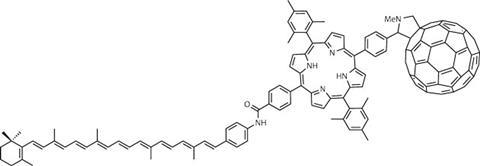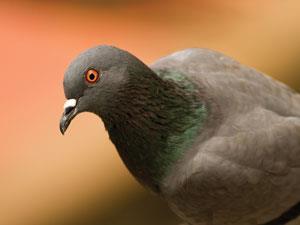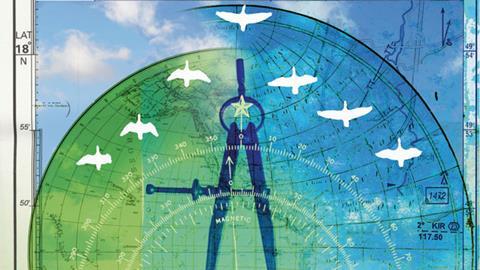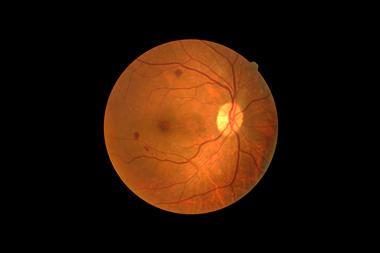What’s the clever chemistry behind the magnetic mechanisms that allow birds and other animals to navigate? Anthony King takes a look
Birds are supreme navigators. In autumn, bar-tailed godwits take off from Siberia and fly over 10,000km to New Zealand. If they are blown off course, the birds can readjust. If scientists move adult starlings by air, the birds correct for the displacement; they seem to possess a GPS with map and compass. It has long been accepted that migrating birds and other animals can use the Earth’s magnetic field for amazing feats of navigation, but precisely how they do so is one of the most enduring mysteries of biology.
In the last few years, physical chemists have arrived on the scene and are working with geneticists, animal behavioural scientists and neurobiologists to delve into how animals sense this field. One theory is that the Earth’s weak magnetic field could influence chemical reactions within sensory cells and thereby allow animals to detect changes in the field, even though – between 25 and 65 microtesla – this field is about 100 times weaker than you would get from a fridge magnet.
Radical pairs in chemical reactions are known to respond to magnetic fields. This involves pairs of transient radicals being created simultaneously, such that the two electron spins, one on each radical, are correlated. Their chemical fate is largely dictated by weak magnetic interactions, so that you get radicals with unpaired electron spins either antiparallel (singlet state) or parallel (a triplet state).
‘Even though the interactions of electron spins with an applied field is very weak, there is enough time to affect the balance between singlet and triplet radical pair states and therefore to change the yields of the products formed from them,’ explains Peter Hore, a physical chemist at the University of Oxford in the UK and a leading light in the role of spin chemistry in navigation. Such a change could be detected and end up as a nerve signal. This is the basis of the radical pair mechanism for magnetosensing.
Magnetic marvels
This mechanism was first proposed for bird navigation back in the 1970s. It was seen as an interesting and quirky idea, but wasn’t taken too seriously due to a lack of experimental evidence. That all changed in 2000 when researchers at the University of Illinois in the US proposed a molecule which might be capable of doing this kind of chemistry: cryptochrome.1
‘In the 1990s, it was discovered that the magnetic compass of birds is light dependent,’ Hore explains. ‘It requires the blue light part of the solar spectrum, so the candidate magnetoreceptor needs to be a biological molecule that will absorb blue light. And there are not so many photoreceptors.’ Step forward cryptochromes, blue-light photoreceptor proteins first discovered in plants in 1993. The fact they are light-activated fits with evidence from birds suggesting that birds can no longer ‘see’ the Earth’s magnetic field if deprived of light.
Four different cryptochromes have since been discovered in the eyes of birds, but it is not known which is involved in magneto-detection. These proteins, however, stand as the only candidate for a radical-pair magnetoreceptor.

Photoreduction of the fully oxidised state of the flavin adenine dinucleotide (FAD) chromophore in cryptochrome is mediated by electron transfer along three tryptophan residues to give a radical pair made of a flavosemiquinone radical and a radical derived from the terminal residue of the tryprophan-triad.2 In plants, the flavosemiquinone form of the cryptochrome protein is thought to be the signalling state so this form may also be favoured in animals. Hore, with Christiane Timmel in Oxford and Devens Gust in the University of Arizona in the US, has used a model system, structurally unrelated to cryptochrome, to show the principle of the radical-pair-based chemical compass. Light-induced radical pairs in this triad model molecule – consisting of carotenoid, porphyrin and fullerene groups – did respond to magnetic fields as weak as the Earth’s.3
‘We have a reasonable idea of what happens when cryptochrome absorbs a blue photon. That triggers electron transfers and produces a radical pair,’ says Hore. ‘Having formed a radical state of the flavin cofactor of the protein, it then undergoes a conformational change that affects its ability to bind to signalling partners and that, it is assumed, is the start of the signal transduction that must ultimately lead to nerve signals going to the brain – but quite what happens in between is not known.’
Of mice, men and butterflies

Evidence for cryptochrome and geomagnetic field detection has also come from genetic studies. These proteins are known to be involved in circadian clocks, enabling organisms to count time. Steven Reppert of the University of Massachusetts in the US became interested in them while deciphering how monarch butterflies migrate from the eastern US to Mexico. Butterflies mainly use a sun compass with a circadian clock to navigate, but Reppert thought they might use magnetoreception as a backup on cloudy days.
He decided to see what happens when you knock out the cryptochrome gene in fruit flies. Flies were trained to detect magnetic fields and had their magnetosensing response knocked out and then restored when gene expression was given back using a human cryptochrome gene.4 ‘It didn’t make sense to me that if other vertebrates were using cryptochrome as a magnetosensor that humans might not be doing the same,’ says Reppert. People have plenty of cryptochrome in their retina and giving cryptochrome-deficient flies a transgene that encoded the human protein allowed the flies to respond as if they had their own protein.5
‘That is pretty remarkable but one has to be careful with the interpretation. We are putting the human protein into an insect brain, and it’s hooking up to the right system there, but whether that system is present in the human retina is yet to be determined.’ Nonetheless, the case for cryptochrome involvement in magnetoreception has strengthened and Reppert says that his lab now has exciting data on monarch butterfly navigation.
The question of how cryptochromes might be ordered in the eye remains elusive. ‘Some of the theoretical predictions say they have to be well ordered but there is no evidence that they are,’ says biologist Richard Holland of Queen’s University Belfast in the UK. ‘To get a direction sense, we would need the [cryptochrome] molecules to be immobilised and perhaps aligned as well, perhaps attached or associated with the rhodopsins, which are the visual receptors,’ says Hore. The lack of evidence for cryptochromes aligning in the eye has been cited as a problem for this model of magnetoreception, but Hore believes ordering could be possible.
Moreover, a neuroanatomical study recently reported finding one specific cryptochrome exclusively in the outer segment of all ultraviolet cones in the retina of chickens and robins, hinting that these receptor cells are possible magnetoreceptors.6 It has yet to be shown that they are rotationally constrained, but boosts the radical-pair idea nonetheless. Roswitha Wiltschko, a bird navigation biologist at the University of Frankfurt in Germany, was lead author of this study. She believes that radical pair mechanism is likely to give birds a direction compass, but she looks elsewhere for an intensity sensor. Wiltschko thinks that magnetite is involved in birds’ magnetosensing abilities. Magnetite is a specific form of iron oxide, which has a stable magnetic moment in the size range 1.2 to 0.05µm, acting as a tiny permanent magnet.
It should be remembered that the geomagnetic field has measurable characteristics: there is the direction of the field lines, which is a directional compass similar to a field compass, but there is also intensity, which decreases from pole to equator and so offers latitudinal information. ‘But the visual sense only involves the magnetic field lines, which give direction, not intensity,’ says Holland. Magnetite was long believed to detect intensity, offering a dual system.
Mystery of magnetite
Hore believes that the cryptochromes in the eye, which detect the geomagnetic field using spin chemistry, is most likely a directional sense, but says it might also provide intensity information. This follows a momentous shake-up in the field of navigation biology after the assumed intensity compass – in the beak – was smashed to pieces by a scientist based in Austria.
Those in the field had been convinced by research describing mineral structures in the upper beak of pigeons, located in sensory nerve endings, as a magnetite-based system for detecting intensity. Then David Keays from the Institute of Molecular Pathology in Vienna stood up at a conference on magnetosensing and demolished these structures. ‘I was the last speaker and they gave me an eight-minute slot to speak. During the conference, people had talked about these magnetosensors and then I stood up and said that’s all wrong. Some people were persuaded by the data, but most of the audience just didn’t believe me,’ Keays recalls.

Most are now persuaded. What Keays had done was analyse almost 200 pigeon beaks using Prussian blue and microscopy techniques to detect iron.7 ‘We went through a long painful process trying to identify these magnetoreceptors, only to discover that they were iron-rich macrophages.’ Macrophages help dispose of unwanted material in cells, and Keays says he saw them actively engulfing iron particles, a waste product in many animals.
The beak remains a favoured site for magnetosensors based on magnetite due to indirect evidence. For example, cutting the trigeminal nerve disorientates birds and leaves them unable to detect a magnetic field. Also, a short magnetic pulse has been shown to disrupt adult birds, similar to how a compass can be remagnitised to point in the wrong direction. ‘If you give the birds a strong magnetic pulse, which would permanently re-magnetise magnetic material such as magnetite, you can change the behaviour of adult migratory birds,’ says Holland. This wouldn’t impact the eye-based mechanism. The disorientation only lasts a few days, explains Wiltschko, who has carried out such experiments on Australian silvereyes. ‘I believe there must be some magnetite receptors in the beak,’ she says, and they are most likely to detect intensity of the field and so give north–south positional information.
Holland views the refuting of the beak sensory structures as marking significant progress in the field, as it had forced many into a prescribed view of how the magnetite system would work. Now, scientists are looking anew at where a magnetite-based system might lie. ‘The thing with the magnetic field is that it pervades all tissue. There doesn’t need to be a focusing organ on the surface of the organism [such as eyes or ears]. That is one reason it has been so difficult to find the magnetic sense,’ says Holland. ‘In theory they could be anywhere in the body.’
The ears have it?
Some researchers remain closely wedded to either the visual system or a magnetite system. ‘The argument rages on, as is the case with most things in animal navigation. For some reason the field seems to be quite polarised, no pun intended, but some of those who have been proposing the magnetite system argue that the visual-based system can’t be correct and must be an artefact of the bird’s visual system,’ says Holland. He has done pulse studies on bats, which indicate that they may use a magnetite-based system.
The ear has also re-emerged as a possible location for bird magnetic detection. David Dickman at the University of Texas in the US identified cells in the brainstem of pigeons that could record the direction, intensity and polarity of an applied magnetic field.8 This is consistent with an iron-based particle receptor, but the study also suggested that what these cells are recording is coming from the bird’s inner ear. Keays has been impressed and plans to do follow-up work on the inner ear, where the iron-rich cells are presumably located. ‘I think incorporating a magnetic sense in a sensory structure that is sensitive to mechanical stimulation makes sense,’ he says.
Hore says a great virtue of the radical pair mechanism is that it can be tested. ‘It is a mechanism that makes solid predictions that can be tested experimentally.’ Hore and Timmel have already shown that cryptochromes are indeed magnetically sensitive.9 Work by Wiltschko and colleagues offered some supportive evidence. Radical pair reactions can be influenced by oscillating as well as static magnetic fields, an effect that can be exploited as a tell-tale test for the presence of radical pairs. Wiltschko reported on European robins subjected to radiofrequency fields.10 Her group found a sensitive, apparently resonant, disorientation response to a weak radiofrequency field at a theoretically predicted frequency (~1.3MHz) for radiofrequency fields of 15 nanotesla, up to 3000 times weaker than the Earth’s field. ‘Arguably it is the most convincing evidence so far for a radical compass in birds,’ Hore says.
Potential applications

The field of navigation is disorienting in its complexity. Other cues implicated in navigation include olfaction, infrasound and starlight. Moreover, it is not just birds that can possess a hidden magnetic compass – fish, amphibians, reptiles, insects and mammals such as the mole rat also have one. The best recorded examples involve pigeons, marine turtles and spiny lobsters. One or more could be using a combination of cues, or one or two types of magnetosensor.
Holland says it has been hard for biologists to get to grips with the theoretical nature of some of the radical-pair papers, but most accept it as a good hypothesis. He describes the involvement of geneticists, biochemists and physical chemists as a ‘real sign of advancement and progression in animal navigation’. Yet there are still many mysteries over how this sense works for many organisms. ‘It is challenging to design experiments and to conceptualise what it might be like for a bird,’ says Keays. ‘But it is astonishing that the basic questions about this sense remain unanswered.’
The work of Hore’s group in Oxford has shaken the field of animal navigation, but Hore believes there could yet be ripples in technological applications. A question that arises out of the growing understanding of animal magnetoreception is whether humans might be adversely affected by the electromagnetic fields to which we are exposed through our use of electrical equipment. This seems unlikely, says Hore: the magnetic fields involved are extraordinarily weak, there is little reliable evidence of any such effects, and biology has efficient mechanisms for coping with elevated levels of free radicals.
Hore recently received European Research Council funding to examine the biophysics of the animal compass and explore the possibilities of magnetic sensing technologies inspired by the coherent dynamics of entangled electron spins in cryptochrome-based radical pairs. Part of this new project will be to explore the feasibility of electronically addressable, organic semiconductor sensors inspired by radical-pair magnetoreception. ‘My prediction is that a lot will come out of this magentoreception business that goes far beyond just how animals navigate.’
Anthony King is a science writer based in Dublin, Ireland
References
1 T Ritz et al, Biophys. J. 2000, 78, 707 (DOI: 10.1016/S0006-3495(00)76629-X)
2 H Mouritsen and P J Hore, Curr. Opin. Neurobiol., 2012, 22, 343 (DOI: 10.1016/j.conb.2012.01.005)
3 K Maeda et al, Nature, 2008, 453, 387 (DOI: 10.1038/nature06834)
4 R J Gegear et al Nature, 2008. 454, 1014 (DOI: 10.1038/nature07183)
5 L E Foley, R J Gegear and S M Reppert, Nat. Commun., 2011, 2, 356 (DOI: 10.1038/ncomms1364)
6 C Niessner et al. PLoS One. 2011, 6, e20091 (DOI: 10.1371/journal.pone.0020091)
7 C D Treiber, Nature, 2012, 484, 367 (DOI: 10.1038/nature11046)
8 L-Q Wu and J D Dickman, Science, 2012, 336, 1054 (DOI: 10.1126/science.1216567)
9 K Maeda et al, Proc. Natl Acad. Sci. USA, 2012, 109, 4774 (DOI: 10.1073/pnas.1118959109)
10 T Ritz et al, Biophys. J. 2009, 96, 3451 (DOI: 10.1016/j.bpj.2008.11.072)












No comments yet